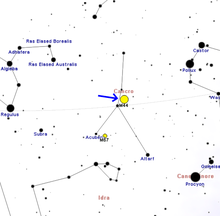
Back Byekorf-sterreswerm Afrikaans مسييه 44 Arabic NGC 2632 Azerbaijani M44 (аб’ект Месье) Byelorussian Ясьлі (зорная скупнасьць) BE-X-OLD Ясли (звезден куп) Bulgarian Messier 44 BS Cúmul del pessebre Catalan NGC 2632 CE M44 Corsican
| Messier 44 / Beehive Cluster | |
|---|---|
 The Beehive Cluster in Cancer (north is to the right) | |
| Observation data (J2000.0 epoch) | |
| Right ascension | 08h 40.4m |
| Declination | 19° 59′ |
| Distance | 610 ly[1] (187 pc) |
| Apparent magnitude (V) | 3.7[2] |
| Apparent dimensions (V) | 95′ |
| Physical characteristics | |
| Mass | ~500–600 M☉ |
| Estimated age | ~600–700 million years |
| Other designations | Praesepe, M44, NGC 2632, Cr 189 |
| Associations | |
| Constellation | Cancer |

The Beehive Cluster (also known as Praesepe (Latin for "manger", "cot" or "crib"), M44, NGC 2632, or Cr 189), is an open cluster in the constellation Cancer. One of the nearest open clusters to Earth, it contains a larger population of stars than other nearby bright open clusters holding around 1,000 stars. Under dark skies, the Beehive Cluster looks like a small nebulous object to the naked eye, and has been known since ancient times. Classical astronomer Ptolemy described it as a "nebulous mass in the breast of Cancer". It was among the first objects that Galileo studied with his telescope.[3]
Age and proper motion coincide with those of the Hyades, suggesting they may share similar origins.[4][5] Both clusters also contain red giants and white dwarfs, which represent later stages of stellar evolution, along with many main sequence stars.
Distance to M44 is often cited to be between 160 and 187 parsecs (520–610 light years),[6][7][8] but the revised Hipparcos parallaxes (2009) for Praesepe members and the latest infrared color-magnitude diagram favors an analogous distance of 182 pc.[9][10] There are better age estimates of around 600 million years[5][7][11] (compared to about 625 million years for the Hyades).[12] The diameter of the bright inner cluster core is about 7.0 parsecs (23 light years).[11]
At 1.5° across, the cluster easily fits within the field of view of binoculars or low-powered small telescopes. Regulus, Castor, and Pollux are guide stars.
- ^ "NGC 2632". sim-id. Retrieved 2020-06-11.
- ^ "Messier 44". SEDS. Retrieved 2009-12-10.
- ^ "Messier 44: Observations and Descriptions".
- ^ Klein-Wassink, W.J. (1927). "The proper motion and the distance of the Praesepe cluster". Publications of the Kapteyn Astronomical Laboratory Groningen. 41: 1–48. Bibcode:1927PGro...41....1K.
- ^ a b Dobbie PD; Napiwotzki R; Burleigh MR; et al. (2006). "New Praesepe white dwarfs and the initial mass-final mass relation". Monthly Notices of the Royal Astronomical Society. 369 (1): 383–389. arXiv:astro-ph/0603314. Bibcode:2006MNRAS.369..383D. doi:10.1111/j.1365-2966.2006.10311.x. S2CID 17914736.
- ^ Pinfield DJ; Dobbie PD; Jameson F; Steele IA; et al. (2003). "Brown dwarfs and low-mass stars in the Pleiades and Praesepe: Membership and binarity". Monthly Notices of the Royal Astronomical Society. 342 (4): 1241–1259. arXiv:astro-ph/0303600. Bibcode:2003MNRAS.342.1241P. doi:10.1046/j.1365-8711.2003.06630.x. S2CID 285922.
- ^ a b Kraus AL; Hillenbrand LA (2007). "The stellar populations of Praesepe and Coma Berenices". Astronomical Journal. 134 (6): 2340–2352. arXiv:0708.2719. Bibcode:2007AJ....134.2340K. doi:10.1086/522831. S2CID 15945900.
- ^ WEBDA
- ^ van Leeuwen, F. "Parallaxes and proper motions for 20 open clusters as based on the new Hipparcos catalogue", A&A, 2009
- ^ Majaess, D.; Turner, D.; Lane, D.; Krajci, T. "Deep Infrared ZAMS Fits to Benchmark Open Clusters Hosting delta Scuti Stars", Journal of the American Association of Variable Star Observers, 2011
- ^ a b Adams JD; Stauffer JR; Skrutskie MF; et al. (2002). "Structure of the Praesepe Star Cluster". Astronomical Journal. 124 (3): 1570–1584. Bibcode:2002AJ....124.1570A. doi:10.1086/342016.
- ^ Perryman M; Brown A; Lebreton Y; Gomez A; Turon C; Cayrel de Strobel G; et al. (1998). "The Hyades: Distance, structure, dynamics, and age". Astronomy & Astrophysics. 331: 81–120. arXiv:astro-ph/9707253. Bibcode:1998A&A...331...81P.
© MMXXIII Rich X Search. We shall prevail. All rights reserved. Rich X Search